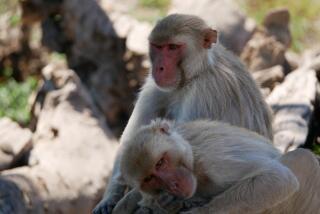BOOK REVIEW : A Compelling Field Study on What Makes Monkeys Tick : HOW MONKEYS SEE THE WORLD <i> by Dorothy L. Cheney and Robert M. Seyfarth</i> University of Chicago Press $24.95, 377 pages
- Share via
I suspect that everyone who has ever lived with an animal has tried to imagine what the world is like through non-human eyes. For those who study primates, the question has evolutionary implications. We share an ancestor with monkeys and apes, and our brains are similar.
Dorothy Cheney and Robert Seyfarth, a wife-and-husband team, spent 13 years studying vervet monkeys in Amboseli National Park, Kenya. In “How Monkeys See the World,” they ask important questions: “Do mental states really exist in the minds of any animal? Or are they artifacts, invented by ethologists as the best means of describing what they have seen? Do we have their minds or ours under the microscope?”
Their answers deal especially with vervets, social animals that live in small matrilineal hierarchies. In infancy each monkey learns his own rank and relationship to the other vervets.
After habituating the monkeys to their presence, the authors confined their research to observations. One exception was their recording of vervet vocalizations, in which they distinguished calls warning of predator leopards, eagles and pythons.
Using techniques perfected by ornithologists, they hid speakers in the trees, then played back the calls to see if the vervets recognized individual voices, and if they responded in the same way to the same warning.
Cheney and Seyfarth, professors of anthropology and psychology, respectively, at the University of Pennsylvania, documented links among dominance, rank and kinship.
But they were unable to find any long-term evolutionary advantage of holding a high rank, although monkey society revolves around rank, and vervets focus exclusively on social relationships.
Displaying long memories, vervets reconcile after spats with the kin of former opponents, as if hedging their bets against future changes in the hierarchy. Each vervet seems to have a detailed mental map of relationships among individuals.
The authors point out that humans, too, have this predisposition to map social relationships. But, unlike monkeys, we reason analogically and extrapolate our sense of relationships to abstract ideas.
Cheney and Seyfarth tread hazardous terrain in their effort to enter the mind of another species. They assume an evolutionary connection among primates, and often refer to experiments with human children who, like adult monkeys, know their own place in a social group. Monkeys, like infants, display fear but not compassion or empathy.
How, then, do monkeys see the world? Not, the authors suggest, as a complex terrain of different things and individuals. Rather, they see a landscape filled exclusively with other monkeys. Moreover, the authors argue, while monkeys may be acutely sensitive to behavior, they respond only to actions.
Monkeys ignore the world around them. They seem to be evolutionarily predisposed to understand relationships between individuals but not between things. Vervets are oblivious, for instance, to python tracks.
The authors note this absence of sensitivity and ask, “Can it really be more important, in terms of survival, to develop a conceptual understanding of social relationships than to recognize the track of a python?”
Evidently not. The East African vervets are fast dying off; only 27% live long enough to reproduce. Between 1978 and 1988, their numbers in the study area fell from 215 to 35. Perhaps the authors have identified a blind spot that explains why some species survive and others die.
Written for fellow scientists and philosophers, “How Monkeys See the World,” assumes a high degree of familiarity with the literature on evolution. For those interested in animal behavior and the evolution and philosophy of mind, it is a fascinating study.
Next: Jonathan Kirsch reviews “Conduct Unbecoming: The Rise and Ruin of Finley, Kumble” by Steven J. Kumble and Kevin J. Lahart (Carroll and Graf).





